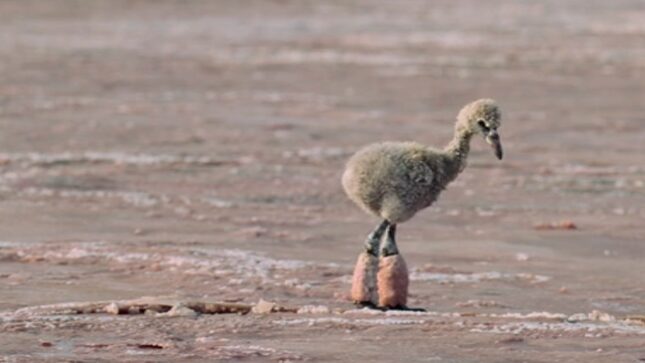Our Planet's Sad Baby Flamingo Is the Heartbreak We Deserve
Latest

About 15 minutes into Our Planet, Netflix’s new David Attenborough-narrated nature documentary series, countless flamingos descend on a salt pan in Africa that has been hit by a sudden deluge. They mate amid the short-lived lake, only to have their hatchlings emerge to a once again scorching hot, bone-dry climate. “The last to hatch step out into a desperately harsh world,” Attenborough somberly explains, as we watch a gray little fluff ball stumble from a muddy nest to the cracked earth below. “Somehow or other the growing chicks must find fresh water to drink.”
Scores of chicks go running across the screen in search of said water. Then, trailing far behind the bunch runs a sad little baby flamingo. “Some cannot keep up,” explains Attenborough. “The salt has solidified around their legs.” Indeed, it looks as though there are two hard, pink casts around the bird’s legs, weighing it down, causing it to stumble and then fall. We see it get back up again and walk off screen as the sun sets—on the day and, we must assume, on its LITTLE BABY FLAMINGO LIFE.
I stopped watching shortly thereafter, feeling it was more sadness than I had signed up for on a Saturday night. I couldn’t stop thinking about the little baby flamingo, though, and I’m not alone, judging from a Jezebel Slack conversation this morning and a perusal of Twitter.
When I returned to watch the rest of the series, I found that sad baby animals are an essential fixture. There are baby orangutans, walrus calves, sea otter pups, and pelican chicks, all existing in various states of vulnerability that are ultimately tied back to human-led climate change. In one particularly awful moment, a polar bear eats a baby seal, left alone on the ice, as its mother watches on. “In the past, she would have built a den inside a ridge on the ice,” says Attenborough of the mother seal. “But now the sea freezes so late that the ice is flat and she had to leave her pup out in the open.” Cut to the baby seal swinging limply from the polar bear’s mouth.
Imperiled baby animals—and cute, cuddly, easily anthropomorphized animals in general—have long been a fixture of nature docs. In the ‘50s, in Disney’s now-infamous White Wilderness, filmmakers drove lemmings off a cliff and made it seem like the furry little creatures were committing mass suicide. More recently, there was March of the Penguins, in which a mother penguin is shown trying to revive her frozen offspring. In 2009, Disney’s G-rated Earth showed the death of a baby elephant and the demise of “the father of two cuddly polar bear cubs,” as the New York Times put it.
But in Our Planet, which was created in partnership with the World Wide Fund for Nature, sad baby animals don’t just serve as a dramatic hook to keep you watching. They serve as a desperate plea on the level of those Sarah McLachlan ASPCA commercials. Again and again, the series uses sad baby animals to entreaty us to please actually give a shit about the destruction of our planet. It systematically connects these cuddly animals’ vulnerability to humans’ destruction of the planet—from things like overfishing, logging, and global warming.
Granted, a couple of Our Planet’s most dramatic, stomach-turning moments step outside of this formula—walruses lethally fling themselves off a cliff and a massive glacier caves, all events that are tied to climate change. But it’s sad baby animals to which the series unfailingly returns, which is just the level of high-stakes emotional manipulation that we humans deserve.
Historically, filmmakers have walked a delicate tightrope with sad baby animal storylines. In 2013, Attenborough had to defend filmmakers’ decision not to interfere in the death of a baby elephant. A few years later, upon the release of Planet Earth II, a clip of a baby iguana making a dramatic escape from a snarl of hungry snakes went viral and served as feel-good fodder on daytime talkshows like Ellen.
In that same series, producers chose to leave out some harrowing footage of chin-strap penguins trying to scale a beach on a remote island. “It was absolute carnage,” said filmmaker Liz White in behind-the-scenes footage. “It was quite heart-breaking, they are trying so hard to get up the beach with broken legs and bleeding, it’s very sobering really. The beach in the afternoon was just a scene of death and destruction.” The Daily Mail reported, “An insider on the show has now revealed that the reason the [BBC] did not explicitly show them dying is because viewers ‘resonate’ with penguins so closely.”
Our Planet’s sad baby animals resonate a little too closely, too—but now that’s the point.